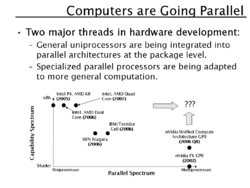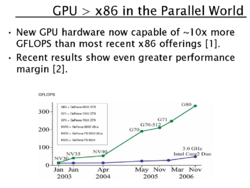Difference between revisions of "GPU.Enabled.Tools.Meeting"
(→Agenda) |
(→Agenda) |
||
| Line 33: | Line 33: | ||
# 10am - noon: GPU algorithm case studies provided by Georgia Tech and Utah | # 10am - noon: GPU algorithm case studies provided by Georgia Tech and Utah | ||
| − | |||
| − | |||
# noon - 1pm: Lunch | # noon - 1pm: Lunch | ||
| − | # 1pm - 5pm: Discussion of | + | # 1pm - 5pm: Discussion of CUDA and specific GPU based algorithm examples |
| + | ##[[Media:Itk-gpu-meeting-Fall2007.ppt|ITK GPU Programming]], by Won-Ki Jeong (Utah) | ||
| + | ##[[Media:Hpc-g80-cuda.ppt|CUDA with Applications]], by Won-Ki Jeong (Utah) | ||
= Directions = | = Directions = | ||
Revision as of 20:49, 11 September 2007
Home < GPU.Enabled.Tools.MeetingGoals
Current trends in processor markets show movement towards highly capable parallel computing (see Fig 1). Spurred on by the computer gaming industry, graphics processing units (GPUs) -- traditionally purely simplistic devices involved in piping pixels to the monitor -- have evolved into very powerful and affordable parallel computing platforms. Companies like nVidia and ATI (recently acquired by AMD) compete to sell their GPUs to video gamers.
The medical image processing community stands to benefit greatly from this trend in the marketplace. The vast majority of medical image processing algorithms are parallelizable (i.e. rather than processing pixels 1-by-1 in a serial manner, operations can be performed simultaneously across the entire image), at least to some degree. Speedups on the order of 50-150x are achievable in this manner.
The purpose of this meeting is to explore the impact of GPU computing on the NA-MIC toolkit. How/when/should we start supporting GPU-based algorithms?
Meeting Attendees
- John Melonakos, Georgia Tech
- Gallagher Pryor, Georgia Tech
- Bruce Fischl, MGH
- Dennis Jen, MGH
- Ron Kikinis, MD
- Ross Whitaker, Utah
Suggested Readings
- High-level explanation of GPUs: HowStuffWorks.com.
- Performance charts of commercially available GPUs: | Tom's Hardware.
- See information from 2006 NA-MIC event on GPU programming.
Agenda
We will meet on Sep 11, 2007 at 10am at MGH. This meeting is meant to be an informal, but guided discussion of the GPU-enablement of NA-MIC algorithms. We encourage participants to come and stay as long as it is relevant to their interests. There will be a projector available for ease of presentation of slides and/or demos, but it is not required of participants.
- 10am - noon: GPU algorithm case studies provided by Georgia Tech and Utah
- noon - 1pm: Lunch
- 1pm - 5pm: Discussion of CUDA and specific GPU based algorithm examples
- ITK GPU Programming, by Won-Ki Jeong (Utah)
- CUDA with Applications, by Won-Ki Jeong (Utah)
Directions
It shouldn't be too difficult for you to find your way to us. If you're taking the subway (called the T in Boston), here are some directions:
- Take the green line inbound to North Station (the end of the line is Lechmere).
- Wait at Causeway St. for the shuttle bus. In the morning rush hour, you should have to wait more than 7 minutes. There are two types of shuttle buses: one looks like a white school bus and the other is a shorter bus. They should be say something like "Navy Yard" at the front and to the top.
- You'll want to be waiting on Causeway Street on the opposite side of big building, known as TD Gardens. If you come out of the wrong subway exit, then just cross the street...
- Here's the shuttle schedule in case you're curious, but it's not totally accurate in your case because there are shuttles that come intermittently between North Station and the MGH Charlestown Navy Yard campus. http://www.partners.org/ourhosp/shuttleschedule/mgh_cny.html
- You'll see a a number of people waiting for the shuttle during that hour, so feel free to ask them if they're waiting to go to the navy yard.
- The ride will take about 10-15 minutes. Get off at the very last stop. Everyone will empty off it and head toward a building that you'll go in as well. If you're confused, ask where building 149 is. I'll meet you at the front at 10am and sign you in the building.

